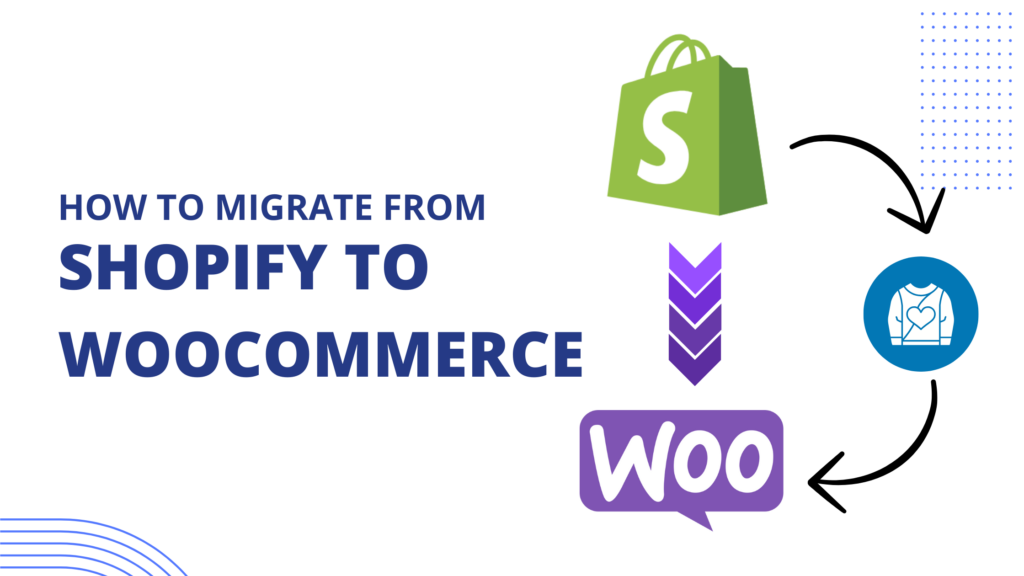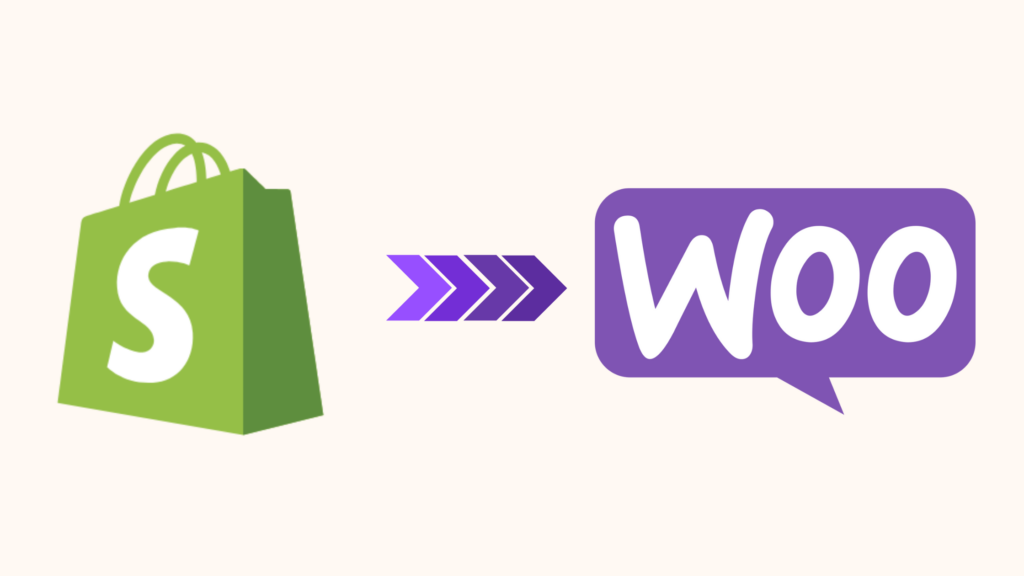How to Migrate from Shopify to WooCommerce
Introduction to Shopify and WooCommerce
Shopify is a user-friendly, all-in-one solution that allows businesses to set up an online store quickly. WooCommerce, on the other hand, is a plugin for WordPress websites, offering flexibility and customization options. Both platforms have their strengths and cater to different business needs. Understanding the basics of Shopify and WooCommerce is essential for businesses considering a Shopify to Woocommerce migration between the two platforms. This subhead sets the stage for exploring the differences and considerations involved in migrating from Shopify to WooCommerce.
Reasons to Migrate from Shopify to Woocommerce
Migrating from Shopify to WooCommerce can offer you more control, flexibility, and cost-effectiveness for managing and growing your online store. There are several reasons why you might consider moving from Shopify to WooCommerce
Cost Savings – WooCommerce is a free plugin for WordPress, whereas Shopify requires a monthly subscription. By using WooCommerce, you can save money on subscription fees.
Flexibility – WooCommerce offers more flexibility in terms of customization. You have greater control over your website’s design, functionality, and features compared to Shopify.
Ownership of Data – With WooCommerce, you have full ownership and control over your store’s data. This means you’re not reliant on a third-party platform like Shopify, giving you more autonomy.
Integration with WordPress – WooCommerce seamlessly integrates with WordPress, the most popular content management system. This allows for easier content management and access to a wide range of plugins and themes.
Scalability – WooCommerce is highly scalable and can grow with your business. You can easily add new products, features, and extensions as your business expands.
Community Support – WooCommerce has a large and active community of developers, users, and contributors who provide support, resources, and updates regularly.
Preparing for the Migration Process
Preparing for the Shopify to Woocommerce migration process involves multiple steps. This will ensure a smooth transition from one ecommerce platform to another. By following these steps and adequately preparing for the migration process, you can minimize the risk of data loss or downtime and ensure a successful transition to your new ecommerce platform.
Backup Data – Before starting the migration, it’s crucial to create backups of all your existing data, including product listings, customer information, orders, and settings. This ensures that you have a copy of your data in case anything goes wrong during the migration process.
Review Current Setup – Evaluate your current ecommerce setup on both the source and destination platforms. Take note of your website’s design, functionality, and any customizations or integrations you’ve implemented.
Choose a Migration Method – Decide on the migration method that best suits your needs and technical expertise. Options include manual migration, using built-in migration tools provided by the platforms, or hiring a professional migration service.
Prepare New Platform – Set up your new ecommerce platform, whether it’s WooCommerce, Shopify, or another platform. Install any necessary plugins or extensions and configure settings to align with your business requirements.
Update Inventory – Ensure that your product listings and inventory are up-to-date on both platforms. Make any necessary adjustments, such as updating product descriptions, images, and pricing.
Communicate with Customers – Inform your customers about the upcoming migration process and any potential downtime or disruptions to services. Provide them with information on how to contact you during the transition period.
Test Migration – Before proceeding with the migration, perform thorough testing to identify and resolve any issues or discrepancies. Test the migration process with a small subset of data to ensure everything transfers correctly.
Schedule Downtime – Plan the migration process during a time when your website receives minimal traffic to minimize disruptions to your customer’s shopping experience.
Steps to Migrate from Shopify to Woocommerce
Whether you’re looking for more flexibility, customization options, or control over your online store, migrating to WooCommerce can offer a range of benefits for your business. From preparing for the migration process to transferring your data and setting up your new WooCommerce store, we’ll cover everything you need to know to make the transition as smooth as possible.
Backing up Shopify Store Data
By following these steps, you can create a backup of your Shopify store data, ensuring that you have a copy of all essential information before proceeding with the migration to WooCommerce. This backup will serve as a safeguard against data loss and help facilitate a smooth transition to the new ecommerce platform.
- Access Shopify Admin – Log in to your Shopify admin dashboard using your credentials.
- Navigate to Settings – Once logged in, navigate to the “Settings” section of your Shopify dashboard.
- Select Export Data – Within the Settings menu, locate the option for “Export Data” or “Export” under the “Account” or “Settings” tab.
- Choose Data to Export – Select the data you want to back up, such as products, customers, orders, or other relevant information.
- Export Data – After selecting the desired data, click on the “Export” or “Export Data” button to initiate the backup process.
- Wait for Export to Complete – Depending on the amount of data being exported, the process may take some time. Wait for Shopify to generate and download the backup file.
- Verify Backup – Once the export process is complete, verify that the backup file contains all the necessary data. Check the file for completeness and accuracy.
- Save Backup File – Download and save the backup file to a secure location, such as your computer or cloud storage. Ensure that the backup file is easily accessible and protected from loss or corruption.
Install WooCommerce on Your WordPress Site
- Access Your WordPress Dashboard – Login to your WordPress website’s admin dashboard using your username and password.
- Navigate to Plugins – In the left-hand sidebar menu, click on “Plugins” and then select “Add New.”
- Search for WooCommerce – In the search bar located at the top right corner, type “WooCommerce” and press Enter. The search results will display the WooCommerce plugin.
- Install WooCommerce – Locate the WooCommerce plugin in the search results and click on the “Install Now” button next to it. WordPress will begin installing the plugin on your website.
- Activate WooCommerce – Once the installation is complete, you’ll see an “Activate” button. Click on it to activate the WooCommerce plugin on your WordPress site.
- Setup Wizard – After activation, WooCommerce will prompt you to run the setup wizard. Click on the “Run the Setup Wizard” button to begin configuring WooCommerce for your store.
- Complete Setup – Follow the prompts in the setup wizard to configure essential settings for your online store, such as currency, shipping options, payment gateways, and tax settings. You’ll also need to enter your store’s address and other details.
- Install Recommended Plugins (Optional) – WooCommerce may recommend additional plugins to enhance your store’s functionality. You can choose to install these plugins during the setup process or skip them for now.
- Review and Confirm – Once you’ve completed the setup wizard, review your settings to ensure everything is configured correctly. Click on the “Finish Setup” button to finalize the installation process.
- Explore WooCommerce – With WooCommerce installed and configured, you can now explore its features and start adding products to your online store. Navigate to the WooCommerce settings to customize your store further and manage your inventory, orders, and customers.
Importing Products from Shopify to WooCommerce
Importing Products from Shopify to WooCommerce involves transferring your product listings from your Shopify store to your new WooCommerce store. Here’s how to do it:
- Export Product Data from Shopify – Start by logging into your Shopify admin dashboard and navigating to the Products section. From there, select the option to export your product data in CSV format.
- Prepare CSV File – Once you’ve downloaded the CSV file containing your product data from Shopify, open it in a spreadsheet program like Microsoft Excel or Google Sheets. Review the data to ensure it’s formatted correctly and includes all necessary information such as product names, descriptions, prices, and images.
- Map Fields – In your WooCommerce dashboard, install and activate the WooCommerce CSV Import Suite plugin if you haven’t already. Use this plugin to map the fields in your Shopify CSV file to the corresponding fields in WooCommerce. This ensures that your product data is imported correctly.
- Import Products – After mapping the fields, upload the CSV file containing your Shopify product data to WooCommerce using the Import feature provided by the CSV Import Suite plugin. Follow the prompts to complete the import process.
- Review Imported Products – Once the import is complete, review your product listings in WooCommerce to ensure that all products have been imported correctly. Check for any missing or inaccurate information and make any necessary adjustments.
- Update Images and Descriptions – After importing your products, you may need to update images and descriptions to ensure consistency and accuracy. Upload any missing images and review product descriptions to ensure they meet your standards.
- Test Product Pages – Finally, test your product pages on your WooCommerce store to ensure that everything looks and functions as expected. Make any additional adjustments as needed to optimize the presentation and user experience of your products.
Importing Customers and Orders from Shopify to WooCommerce
Export Data from Shopify
- Log in to your Shopify admin dashboard.
- Go to the “Settings” section and select “Export” under the “Data Export” tab.
- Choose “Customers” and “Orders” as the data types to export.
- Select the desired date range for the export and click on “Export Customers” and “Export Orders.”
Prepare Data for Import
- Once the export is complete, you’ll receive CSV files containing customer and order data.
- Open these CSV files in a spreadsheet program like Microsoft Excel or Google Sheets.
- Review the data to ensure it is accurate and properly formatted for import into WooCommerce.
Install WooCommerce Import Plugins
- In your WooCommerce admin dashboard, go to the “Plugins” section and select “Add New.”
- Search for and install a WooCommerce import plugin that supports importing customers and orders from CSV files.
Import Customers into WooCommerce
- Navigate to the import section of the WooCommerce plugin you installed.
- Select the option to import customers and upload the CSV file exported from Shopify.
- Map the fields in the CSV file to the corresponding fields in WooCommerce, such as email address, first name, last name, etc.
- Start the import process and wait for it to complete.
Import Orders into WooCommerce
- Repeat the import process for orders by selecting the option to import orders and uploading the CSV file exported from Shopify.
- Map the fields in the CSV file to the corresponding fields in WooCommerce, such as order number, customer ID, product ID, etc.
- Start the import process and wait for it to complete.
Review and Verify Data
- Once the import process is complete, review the imported data in your WooCommerce admin dashboard.
- Verify that all customers and orders were imported correctly and that there are no missing or duplicate records.
Applying SEO Settings and Redirects
Update SEO Settings
- Set up SEO-friendly permalinks on your WooCommerce website, ensuring that URLs contain relevant keywords and are structured logically.
- Configure meta tags, including meta titles and descriptions, for each product, category, and page on your new WooCommerce site. Ensure that these tags accurately reflect the content and keywords relevant to each page.
Implement 301 Redirects
- Set up 301 redirects from your old Shopify URLs to their corresponding URLs on your new WooCommerce site. This ensures that visitors who access your old URLs are automatically redirected to the appropriate pages on your new site.
- Use a plugin or manually configure redirects in your .htaccess file to redirect old URLs to their new equivalents. Be sure to redirect all relevant pages, including product pages, category pages, and any other important landing pages.
Submit Updated Sitemap to Search Engines
- Generate a new XML sitemap for your WooCommerce website and submit it to search engines like Google, Bing, and Yahoo. This helps search engines crawl and index your new site’s pages more efficiently.
- Use tools like Google Search Console to monitor crawl errors and ensure that search engines are successfully indexing your new site.
Update Internal Links and References
- Update internal links within your website to point to the new URLs on your WooCommerce site. This includes updating navigation menus, footer links, and any other internal links that may reference your old Shopify URLs.
- Check for and update any external links that may be pointing to your old Shopify site. Reach out to the owners of these websites to request that they update the links to your new WooCommerce URLs.
Monitor SEO Performance
- Keep a close eye on your website’s SEO performance after the migration to WooCommerce. Monitor changes in search engine rankings, organic traffic, and other key metrics to ensure that the migration has not negatively impacted your SEO efforts.
- Make adjustments as needed to optimize your site’s SEO performance over time, including refining meta tags, improving site speed, and optimizing content for relevant keywords.
Post-Migration Checks
After completing the migration process from Shopify to WooCommerce, it’s essential to perform post-migration checks to ensure everything is functioning correctly. Here’s a detailed explanation in simple steps:
Review Data Integrity – Verify that all your data, including product listings, customer information, orders, and settings, has been successfully migrated to WooCommerce. Check for any missing or inaccurate data that may have occurred during the transfer.
Test Functionality – Thoroughly test the functionality of your new WooCommerce store, including browsing products, adding items to the cart, and completing the checkout process. Ensure that all website features, such as payment gateways, shipping options, and tax calculations, are working correctly.
Check Design and Layout – Compare the design and layout of your WooCommerce store with your previous Shopify site. Ensure that your website’s appearance, including theme customization, branding elements, and navigation menus, matches your expectations.
Verify Links and URLs – Check all internal and external links on your website to ensure they are working correctly and directing users to the intended pages. Update any broken or outdated links and ensure that URLs are SEO-friendly.
Test Mobile Responsiveness – Test your WooCommerce store’s responsiveness on various devices, including smartphones, tablets, and desktop computers. Ensure that your website displays properly and functions smoothly across different screen sizes and resolutions.
Check SEO Settings – Verify that your SEO settings, including meta titles, descriptions, and keywords, have been transferred correctly to WooCommerce. Use tools like Google Search Console to monitor any changes in search engine rankings and address any SEO issues promptly.
Monitor Performance – Keep an eye on your website’s performance metrics, such as page load speed and server response time, using tools like Google PageSpeed Insights or Pingdom. Optimize any areas that are causing slowdowns or performance issues.
Backup Data – Once you’ve confirmed that everything is working as expected, create a backup of your WooCommerce store to ensure that you have a recent copy of your data in case of any future issues or emergencies.
Conclusion
Migrating from Shopify to WooCommerce is a manageable process with careful planning and execution. By following the steps outlined in this guide, you can successfully transfer Shopify to WooCommerce while minimizing disruptions to your business operations.
Remember to thoroughly prepare for the migration, test the process, and perform post-migration checks to ensure everything is functioning correctly .
With WooCommerce’s flexibility and customization options, you can create a unique and tailored online store that meets your business needs. Embrace the opportunity to unlock new features and capabilities while maintaining control over your ecommerce presence.




